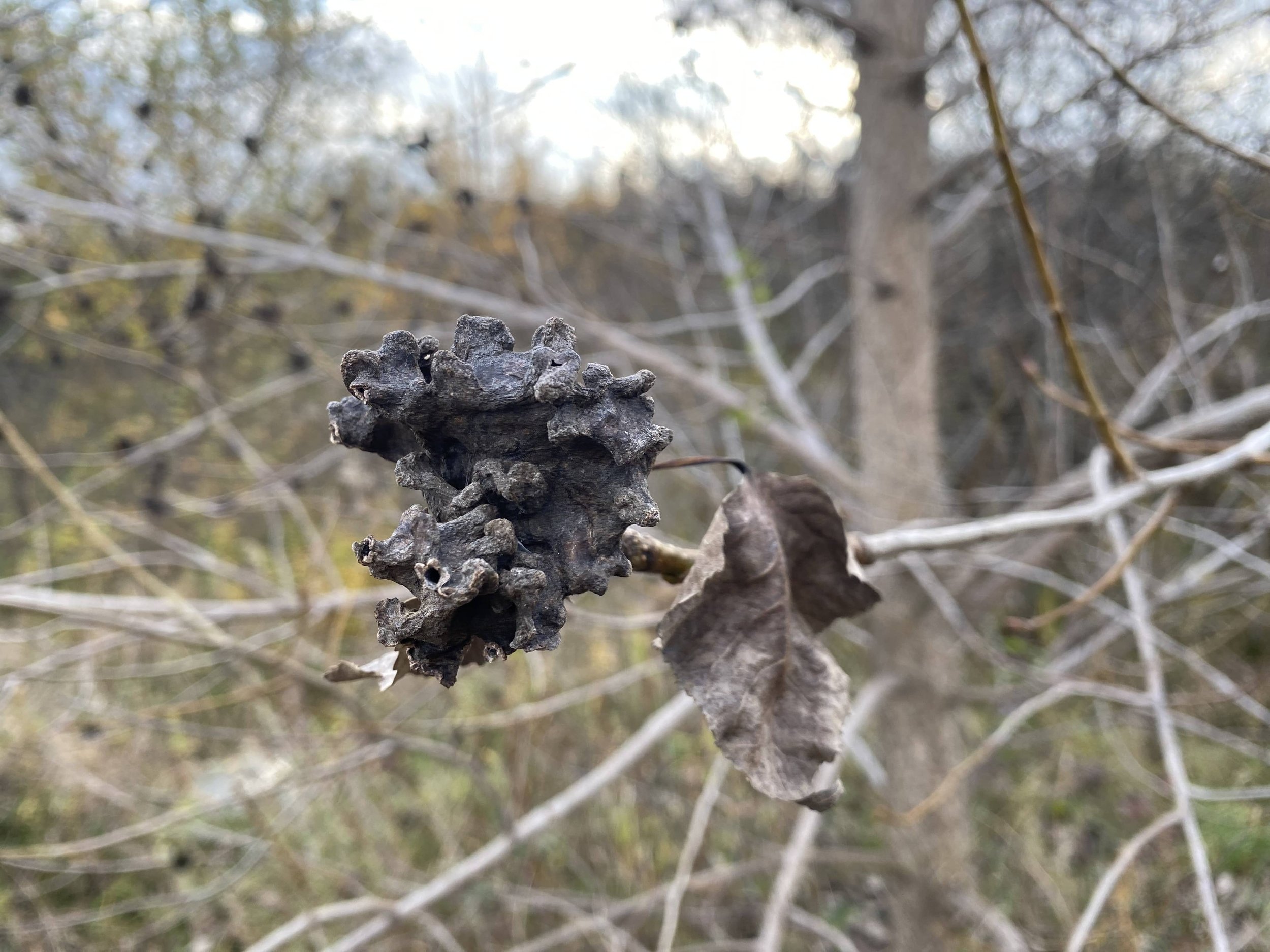Poplar Vagabond Gall Aphid
Strange finds at Sheehy ct, 2023.10.27
I have been keeping a Question Book for years. It’s the greatest textbook I have ever owned. Each loving volume has been authored in partnership between the land and my own geysering, never-settling, curiosity. There have been many questions answered through research in my own library, the local university library, and online. For as many questions which have been answered, there are pages of unanswered mysteries. This is not for lack of searching, but perhaps the research has not come out yet, or I just don’t know where to look. Luckily today will be an indepth answer as to what the hell I have seen growing on the Poplar trees.
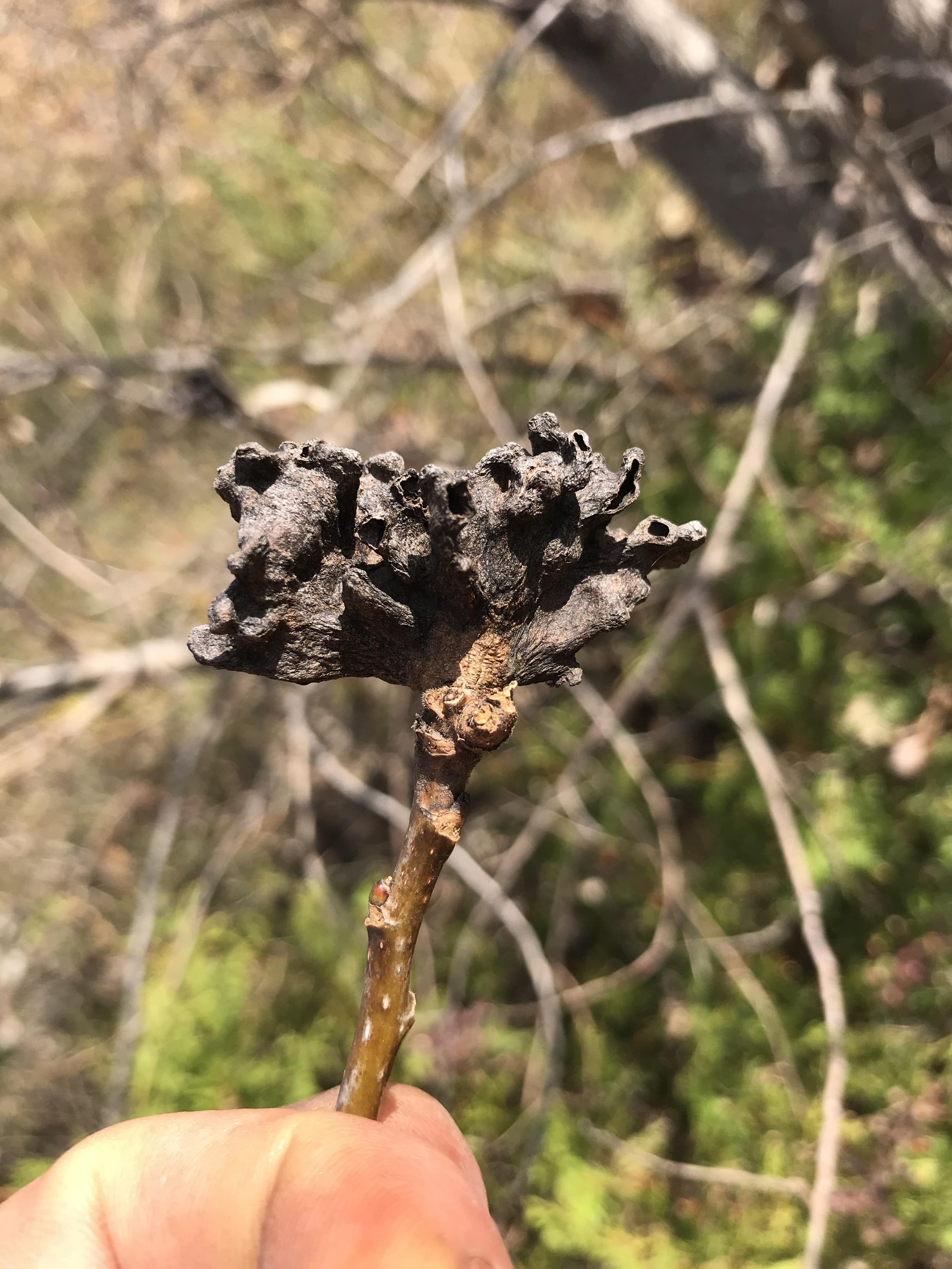
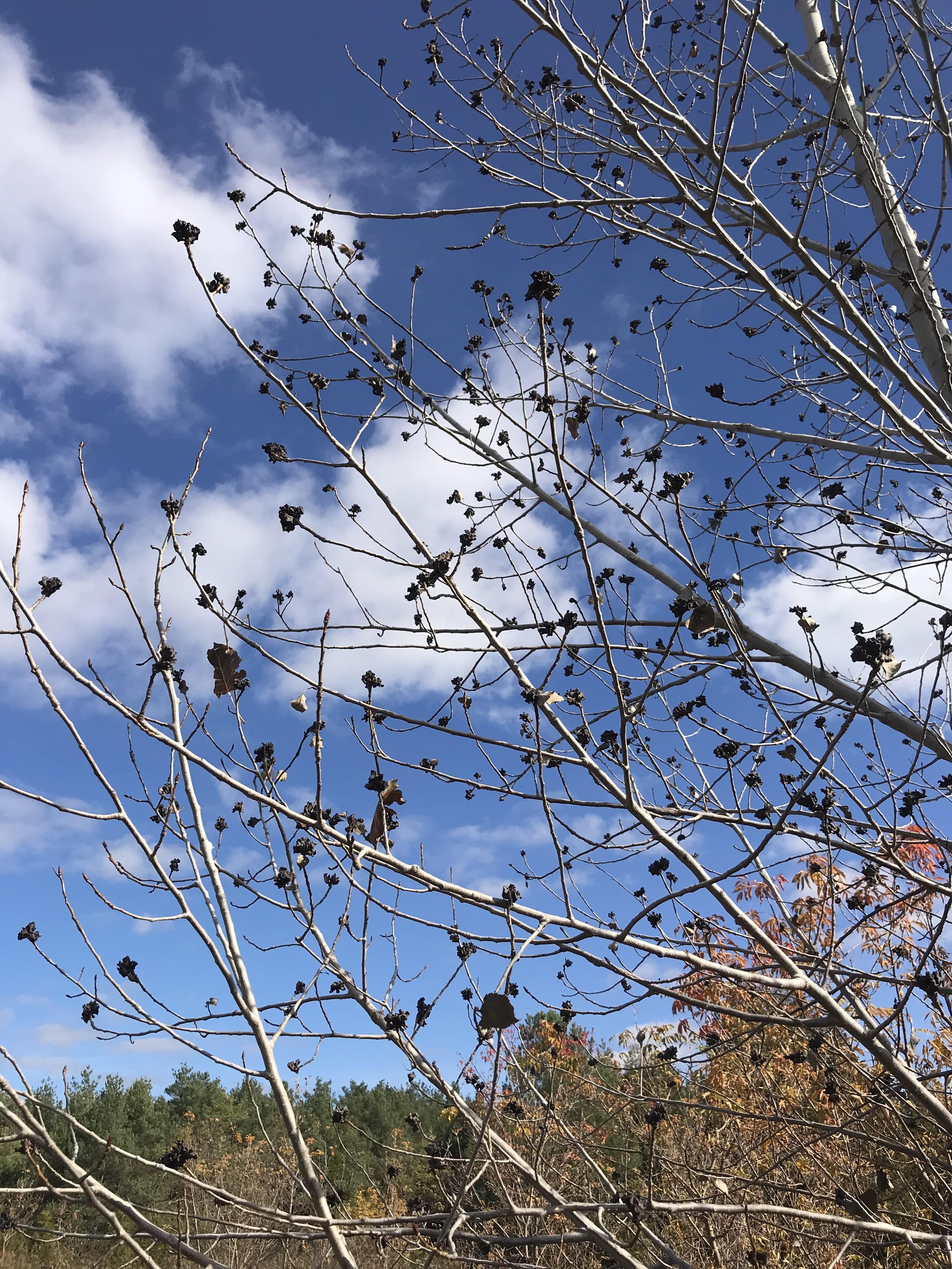
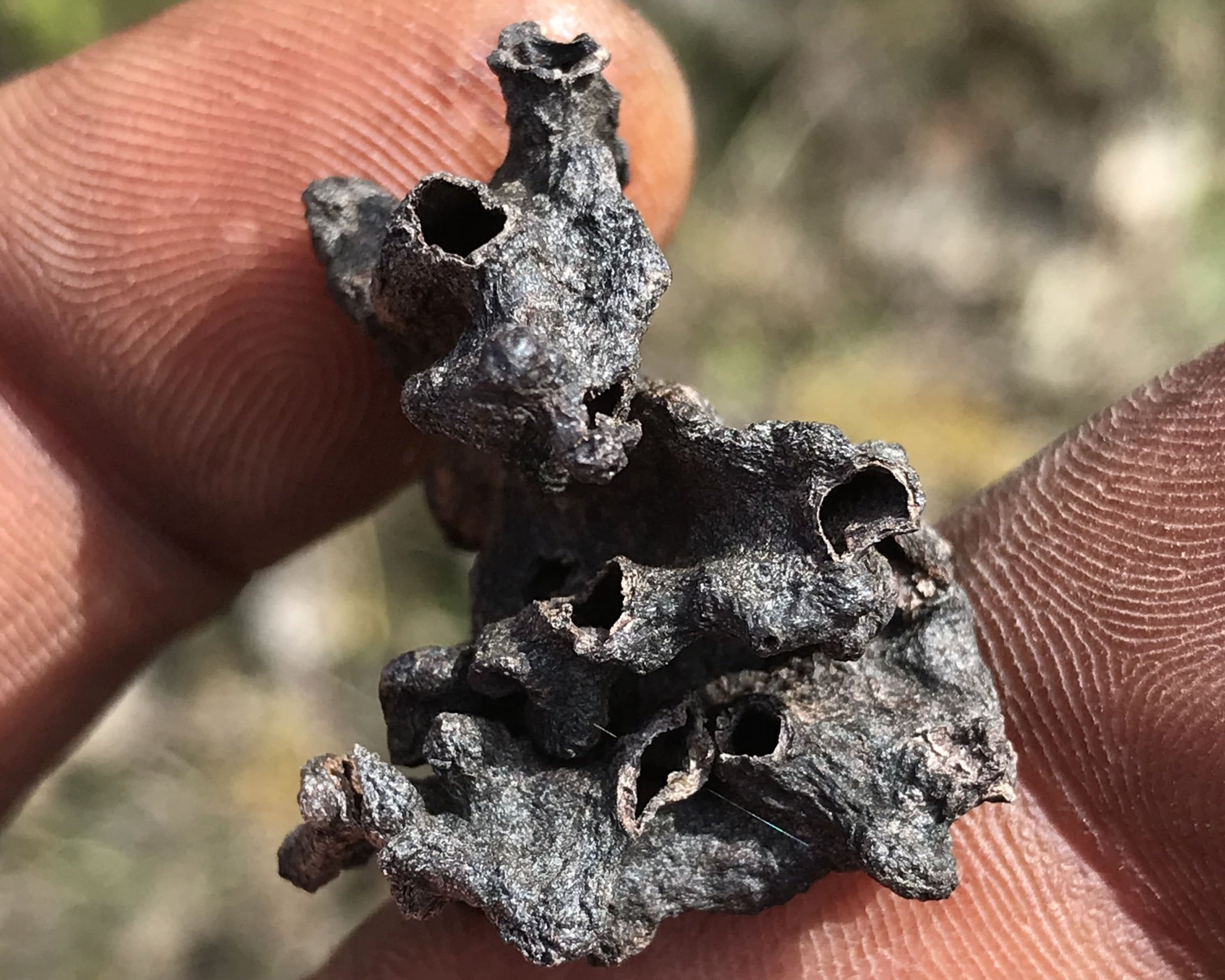
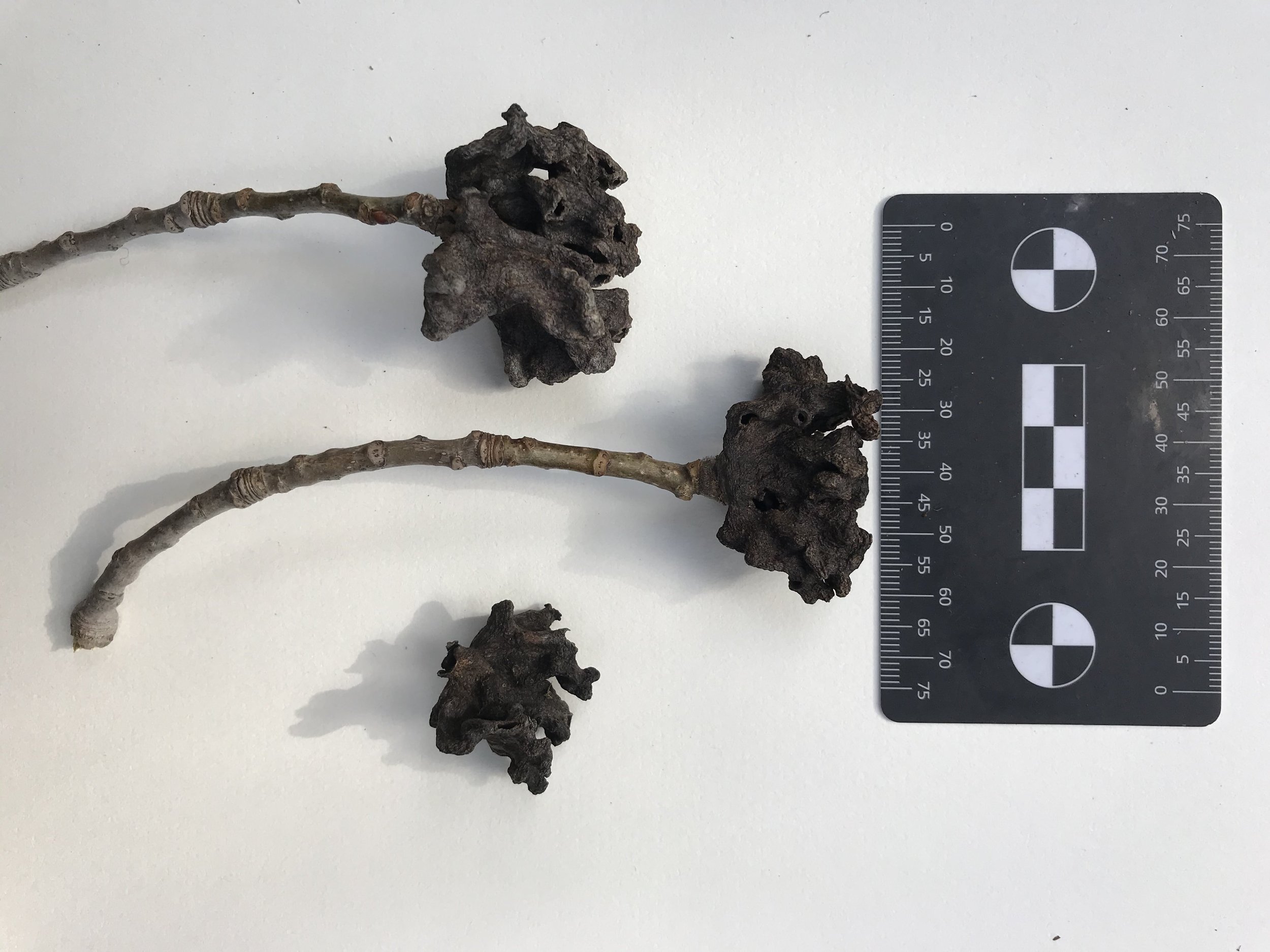
I first found this strange growth on a ride looking for bird tracks at the edge of a Corn (Zea mays) field back in the Summer. I was riding along an battered old road which was blocked off by a concrete jersey barrier. The road itself was falling into disrepair and the roadsides had overgrown on either side by mostly non-native species and was littered with household and construction waste. I immediately stopped when I saw some dark pouchy, or pocket like things at the branch tips of an Eastern Cottonwood (Populus deltoides). They were about 5 - 6 cm (1⅝ - 2⅜ in) wide, irregularly wavey but if flattened only about 3 mm (⅛ in) thick. They were leathery like an old Turkey Tail Polypore (Trametes versicolor) and were growing at the tips of the branches. I wondered if this was a sign of stress that the tree was showing or was it something else? Upon further inspection I realized that there were so many and it seemed uniform in their particular ununiformity that they must have been something else, maybe a gall?
I did a little bit of research and turns out, it was a gall! Poplar Vagabond Gall Aphid (Mordwilkoja vagabunda) is the co-creator of this impressive growth along side a variety of Populus spp. Aphids just seem to be everywhere, so why not the Poplars as well! They have a somewhat cryptic life cycle, but here is what I have sorted out.
When the young females (and it’s only females at first) emerge in Spring around the middle of May, they crawl out to the new growth at the terminal ends of branches of a chosen Poplar tree. They then pierce the far ends of the petiole (leaf stem) and begin sucking on the juices. When this happens the tree reacts by creating these beautiful apartments (the galls) for the aphids within about a week. These galls are initially leathery in texture and green in colour, and enclose an aphid of the first generation of the year, which again, are all females (singular: fundatrix, and I imagine pluralized as fundatrices). In about two to three weeks, the wingless viviparous (live birthed) parthenogenetic (clones of their mother) female aphids will be birthed. This generation is called the fundatrigeniae. They pupate and transform into flying adults (alates) and begin to leave the galls by the end of June. Where are they going? It’s unclear. What is certain is that there is an unknown secondary host which the aphids then begin feeding on. While inhabiting the secondary host, there are a couple more live birthed clonal generations which inhabit that secondary host, but come mid September, an adult egg laying generation (sexuparae) will return to the galls in their first host tree and begin laying eggs which will eventually hatch (oviparous, meaning birthed from eggs) both females and males. This generation of females and males will mature and molt about four or five times before mating. Each of the mated females will then lay a single egg in the gall which they are inhabiting, within three to five days later. Eggs overwinter until Spring when the whole cycle begins again.
Video still from “Poplar Vagabond Gall Aphid (Aphididae: Mordwilkoja)” by Carl Barrentine.
The galls start as bright red in colour, and then turn to a yellowy-green and then darken to black and hardening over the growing season. The second time I found these galls, which was only last week, they were also on an Eastern Cottonwood on the edge of a construction area which had been cleared a few years earlier and the edges of the area which was cleared were slowly repopulating. The galls looked dark, blackish, they had holes. When I returned to the trees of my first sighting at Sheehy ct. on October 27th to take another look, the galls felt brittle and similar, though a little thinner, than the cardboard of an egg carton.
So looking back on the times I have found these galls, both times appearing on Populus deltoides in habitats that weren’t the healthiest places to live, I wonder if harder growing conditions for the tree create better conditions for the Vagabond Gall Aphids somehow? Maybe the trees are already putting so much energy into surviving harsh conditions that the aphids encounter fewer natural defences?
Because the aphids are pretty much contained within the galls, the harm to the tree is highly localized and the aphids don’t actually end up harming the tree much at all. For this reason, I think galls are a way that the tree reacts to instead of try and overcome and defeat a problem instead works to contain and compartmentalize. This is also how trees work with fungal infections like Cobra Canker (Eutypella parasitica) and wounds caused by breaks and deer antler rubs. I wonder if this is the general habit of trees when it comes to harm? I also wonder if one tree has an infestation of aphids, and creates the galls for them, does this act spare other suitable host trees nearby? Can a tree “take one for the team”, creating shelter for the aphids, while the other trees can thrive without them? I have noticed at the first site where I found the galls, only two of maybe 6 or 7 Poplars seem to have the galls. Something to keep an eye out for in the future.
While the secondary host for the Poplar Vagabond Gall Aphid may be uncertain, one source says it may be a grass of some kind, another says possible Lysimachia species, two species of which have been found nearby Fringed Loosestrife (Lysimachia ciliata), or the non-native Scarlet Pimpernel (Lysimachia arvensis) which I have been found only a few meters from the second infested Eastern Cottonwood tree.
Poplar Vagabond Gall Aphid on gall from Andrew Wesley Legan paper “First record of anti-predator behavior in the gall-forming aphid Mordwilkoja vagabunda”.
So again, these galls will be on my watch list and I’ll be adding another alert to google scholar in hopes of learning more as more information becomes available. I’ll be looking around here in Guelph and likely everywhere else I go in hopes of finding more of the Poplar Vagabond Aphid galls so I can note any differences in form, or colour, or habit and try and answer some of the questions I pose above.
If you learn anything, let me know!
To learn more:
Petiolegall Aphids : Swollen or disfigured leaves of poplars (pdf)
First record of antipredator behavior in the gall-forming aphid Mordwilkoja vagabunda
Poplar Vagabond Gall Aphid (Aphididae: Mordwilkoja) video on youtube.com by Carl Barrentine
InfluentialPoints.com entry on Mordwilkoja vagabunda
Life History and Gall Development of Mordwilkoja vagabunda (Homoptera: Aphidae) on Populus deltoides
Life History and Gall Development of Mordwilkoja vagabunda (Homoptera: Aphidae) on Populus deltoides. Part II—Gall Development
The Insects and Arachnids of Canada part 22 : The Genera of the Aphids of Canada - Homoptera : Aphidoidea and Phylloxeroidea : pg 472 (pdf)

